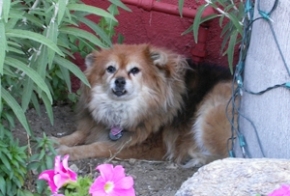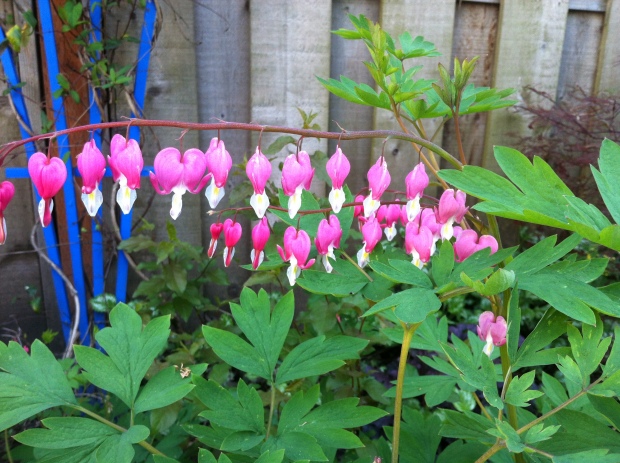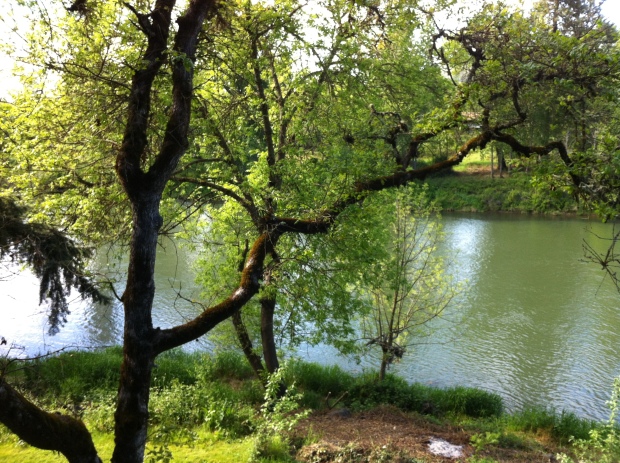Ten years ago this month, Mr. NightSky and I purchased a small hotel in Palm Springs. We had lofty goals, crashes of reality, and everything in between. One other thing we had, which we could not have predicted, was Louise.
It was the end of that first summer, the slow season, and we had taken the opportunity to run out for a quick dinner. Returning, we pulled into the hotel’s small parking lot, and saw a small dog loitering around. She was happy to come to us; in fact, she acted like she expected us. “Oh, good, you’re back!” She was cheerful, but looked a bit the worse for wear. We brought her into the office, gave her food and water, and made a bed for her there for the night.
The next day we took her photo and made flyers to post around the neighborhood. She had a small collar, but no tags. The little dog appeared to be part Pomeranian and part Shetland Sheepdog. Her nails were very overgrown, and she definitely needed dental work. But she was a cheery little thing. A couple of days went by with no response to flyers, newspaper ads, Craigslist, shelter inquiries, or wandering the neighborhood.
Finally a couple from the condo complex next door stopped by the office. They had seen the posters, but wanted to check to make sure it was the dog they were thinking of, and to talk to us about her. She was, and they did. It seems that their neighbor was probably her owner, and would keep her leashed on the balcony for a day or two or longer at a time. The couple who visited us had already been concerned about her welfare, and now begged us not to return her to her owners. We talked a lot about it, and finally said that if the owners didn’t come forward to us, we would keep her.
We named her Louise.
We took her to the vet, got a complete check-up, had some teeth removed, nails clipped, and groomed. The vet estimated her age to be 12 at that time. We thought with all that, we would probably only have her a couple of years. But she stayed with us for another seven! Already with some blindness, her eyesight continued to fail, but that never stopped her.
She was the official hotel mascot, by her own decision. The guest loved her, and would pack treats for her in their luggage, from as far away as Canada. She wasn’t pushy, but she would quietly join select people while they sunbathed by the pool, or while they read in the chair just outside their room. Often I would look out from the office, and there she’d be, lying on the ground next to a guest on a chaise.
Some guests even went the extra mile, like Uncle Bacon. Uncle Bacon was a summer visitor from England, and each morning would fry a few pieces of turkey bacon for Louise. She barely left Uncle Bacon’s front door the whole length of his stay. Of course, I warned him that her digestive system was hardly used to a steady diet of bacon, but he pooh-poohed me, and he suffered the consequences. Louise was crushed when he left. She would continue waiting outside his door, though other people–people who had no bacon–came to stay.
Kids loved her, especially when she had a puppy haircut during the summer–she actually looked like a puppy. Or a fox. Or a fox puppy.
Of course, anyone eating at one of the patio tables sparked her interest, but again, she wasn’t intrusive. She’d just casually stroll over, sit or lie down, and wait. They caved each and every time.
Louise loved her little adventures, too. I think that her prior escape had given her a taste for wandering, and we had to chase her down on more than one occasion. One evening we got a call from a hotel several hundred feet down the street (our hotel was on the main drag, a four-lane, 50-mile-an-hour highway).
“Do you have a dog named Louise?” the person at the hotel asked. “Because she’s here, in our bar.”
Now this hotel was down the road, and on the other side of the four-lane highway. And Louise was half-blind. And it was close to dark out. How on earth had she made it over there alive? She must have decided to celebrate by partying once she made it across.
Mr. NightSky drove over to pick her up. He walked into the bar, and there was Louise, up on a table, surrounded by admirers. “Oh, don’t be mad at her,” they chorused.
That Louise. We miss her still.















